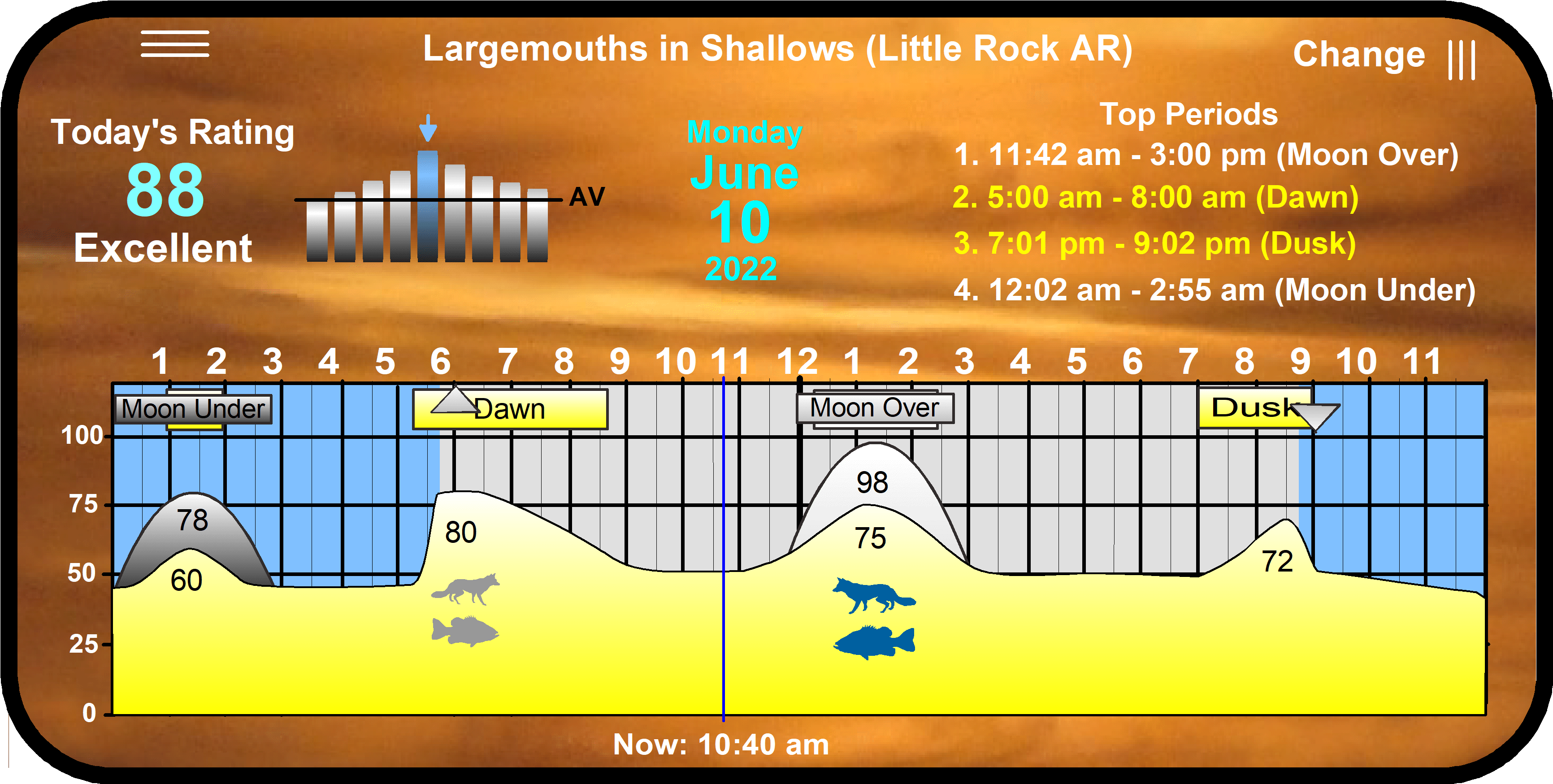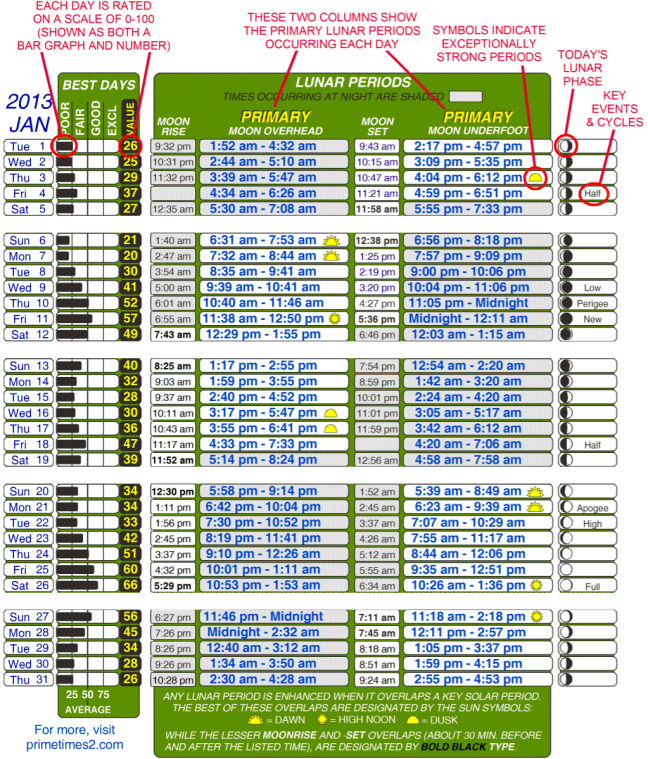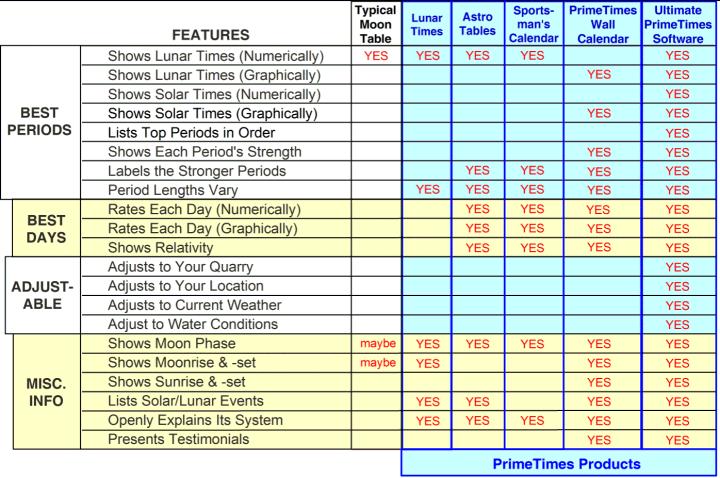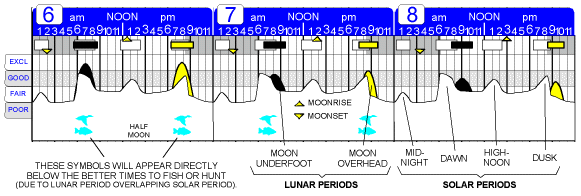1. Does PrimeTimes really work? (See that article in the next section.)
2. Does PrimeTimes work in my area of the U.S.?
Yes. Because of the installation of time zones over a century ago, the moon and sun reach the same point in the sky at the same time for all locations of earth.
For example, say you are in New York and it's high-noon. Where is the sun? Right over your head. Now say you are in Los Angeles and it's high-noon. Where is the sun? Right over your head. And so it goes for any time zone around the world. It takes the sun and moon approximately one hour to travel from one time zone to the next, thus the formula used when the time zones were devised.
3. Do I ever need to adjust the lunar or solar times?
We set our times to the CENTER of any given time zone (ie: 78 degrees for the Eastern Time Zone, 93 degrees for the Central, 108 degrees for Mountain, 123 degrees for Pacific, 153 degrees for Alaska/Hawaii, all the way to 3 degrees for England). If you fish or hunt within a few degrees of any of these, there is no need to adjust anything. If, however, you are on the far edge of your time zone, the times could be as much as 30 minutes off. While this is still within acceptable limits (you should be out there at least one hour before any activity time, anyway), some folks like to be precise...bless their hearts. In this case, use this simple formula:
Find the number of miles you are from the center, and divide it by 12. The result is the number of minutes you need to adjust. If you are to the WEST of center, ADD these minutes to all the solar/lunar times. If you are to the EAST of center, SUBTRACT.
For example, anglers in Miami would add approximately 12 minutes to all times)
(You could also get the Ultimate PrimeTimes software, which does these corrections--and much much more--for you.)
As for latitude, our calendars are geared for 35 degrees N. latitude, which runs along the northern borders of Arizona, New Mexico, Arkansas, Tennessee, and North Carolina. If you are farther south or north than this, don't worry. Latitude has very little effect on the best times, and even less on the best days. Not until you get above 50 degree N. latitude (approx. U.S. Canadian border) should you even begin to consider a few things. These are discussed in #12 below.
Finally, all PrimeTimes forecasts are adjusted for Daylight Saving Time.
4. Which is more important, the best days or the best periods?
Think of these as two completely different factors. The Daily Rating" (on a scale of 0 - 100) shows how that entire 24-hour day stacks up against all the other days that week or month. It is based on the moon phase, proximity, angle, etc., which basically last all day and night. Meanwhile, the "Best Periods" show those hours of each day when the moon and sun's influence peak, based on their postion in our sky (ie: overhead and underfoot).
Consequently, consulting the "Daily Rating" is generally more important, because it means all of that day's hours--both good and bad--will be better when the rating is high and poorer when the rating is low. On the other hand, once you are on the water or in the field, that day's best periods are all that matter.
All this is much easier to understand with the PrimeTimes Wall Calendar, which graphically shows each day's periods via a peaks and valleys format.
5. What do you mean by "Moon Overhead" and "Moon Underfoot?"
As the name implies, the "Moon Overhead" period is that time each day when the moon reaches its highest point in your sky. Then--approximately 12.5 hours later, it has moved to being right under your feet on the other side of the earth. That's the "Moon Underfoot" period.
6. Are these the best times to go?
Moon-wise, yes.
7. Can fish and game be active during other times of the day?
The problem with the so-called "moon tables" today is that you can be mislead into thinking their prescribed lunar periods, often called "Major" and "Minors" or "Primary" and "Secondary," are the only times to find activity. This simply isn't true. There's another not-so-subtle object floating around out there that must always be considered, as well. It's called the sun, and it's solar periods of "Dawn, High-Noon, and Dusk" have just as much if not more potential to influence the daily activities of fish and game.
8. Explain the three solar periods and why they are important to fish and came activity.
With the exception of a few nocturnal creatures and most teenageers, Dawn sets the world in motion. After so many hours of monotonous darkness, they can finally see their surroundings. It's time to stretch, flex, and find something to eat. On a year-round basis, no other daily period has as much potential for seeing the beginning of some kind of activity. And no other is as predictable.
Dusk, of course, is sort of Dawn in reverse. But since here visibility is slowly being lost, Dusk can be as much of a turn-off as anything. What it does have going for it is it often gets the creatures up and moving back to their liars for the night. Fish may feed in aniticipation of the coming darkness, especially on the insects that become more active as the sun and breezes fade.
High Noon is the most ignored and least understood period of them all. Yet, on a yearly basis it's often the best one overall to fish. Here are the major factors High Noon has going for it:
a) With the sun penetrating its strongest into the water of the day, plankton blooms are the greatest. This leads to feeding minnows, which leads to active predators. The catch here is that you must often fish deeper, away from the shorelines so dear to the average angler's heart.
b) If the creatures fed at Dawn, now it's lunchtime--halfway between Dawn and Dusk.
c) It's the sun's highest electromagnetic period of the 24-hours, just like the Moon Overhead period is for the moon.
d) In the cooler months, it marks the front end of the day's warmest water, which can stimulate fish activity.
This solar trilogy of Dawn, High Noon, and Dusk, has and always will lay the foundation for the daily activity cycles of all earth's creatures.
9. If these solar periods are so dominant, where does the moon come in?
If the moon isn't proof God has a sense of humor, maybe it's Nature's way of guaranteeing the preservation of the species. If all life followed a solar pattern all the time, it would be as easy for coyotes to wipe out all the rabbits as it would be for man to wipe out all the coyotes. But, for one reason or another the bass, deer and field mice suddenly stop following a solar pattern and seem to virtually disappear. The availability of food, certain environmental conditions, seasonal mating patterns, and the presence of man himself can and often will be factors. But so apparently is the moon, with its mystical, misunderstood powers.
Perhaps a few millennia ago some nonconformist named Grog discovered that land and water creatures often switch over to a lunar cycle and hence kept bringing home piles of meat when no one else was. (Maybe they made him the official guru of his tribe.) The moon's influence has been documented in the earliest writings of naturalists to as far back as cave drawings. Commercial fishermen and hunters follow the moon, as do guides, horticulturists, and many others who make a living from harvesting earth's bounty.
10. What's the power behind the lunar influence?
Theories range from the moon's gravitational pull tugging on the water in an animal's body to its electromagnetism realigning the microscopic iron particles in the blood. We do know that back when life was first forming in the sea, the moon was five times closer to the earth than now and the tides were over a mile high! This twice-a-day phenomenon had to have left a deep impression on all life, which perhaps has been passed down genetically to its progeny.
Actually, our knowing exactly how the moon influences life is not as important as accepting the fact that, at certain times, it does. From there we can start a retro-study of the big picture and look for patterns to develop that can and will help us better predict the activity times of our favorite species
11. Why don't my local tide charts agree with PrimeTimes?
They should be pretty close, because both are based on the moon's position each day.
When the moon is overhead or underfoot, there is a high tide in that area and there's
also a PrimeTimes lunar period. If your tide table seems to disagree with PrimeTimes,
it's because
a) the time of an actual high tide in any given location is also determined
by other factors, such as the terrain both on and offshore, and known lag effects (when
the tides come in later than usual for various reasons);
b) PrimeTimes is not meant to
be a tide table. It's an activity forecaster. Among other things, it shows you the two
times each day when the moon is in position to present it's strongest electromagnetic
energy, which are known to affect fish and game. These two periods are actually
"windows" with a beginning time and ending time...centered on when the moon is directly over your head and (some 12.5 hours later) directly under your feet on the other side of the earth. The length of these periods changes day to day, due to certain cycles of the moon. In this respect, PrimeTimes is astrophysically accurate. The best advice is to trust and use both PrimeTimes and your area's tide chart.
12. Do the calendars and software work outside the U.S.?
As stated above in #2, PrimeTimes' forecasted times are based on 35 degrees N. Latitude and whichever Longitude runs down the center of any given time zone around the world. So, yes, these calendars work just fine outside the U.S. anywhere in the Northern Hemisphere. They can do a good job in the Southern Hemisphere, as well, but with a few considerations.
The software version ("Ultimate PrimeTimes") works even better, because you can program in your exact coordinates.
A complete discussion of Question 12 can be found on our main site at the bottom of
the Software Features page.)
13. Why do different activity forecasters often disagree on their best times?
Since anybody can publish a fish & game activity calendar (and many do), it depends on what they are basing their predictions. These can range from astrology and biorhythms to when Chief Buzzard Feather dropped that monster water buffalo in the Australian spring of 1874.
Most, of course, use the moon. Yet even these often differ to one degree or another, because while the criteria are the same, the formulas are different.
For example, say the moon is directly overhead tonight at 9:00 p.m. Some tables will predict 8:00 to 10:00 p.m. as a primary lunar period, starting one hour before the peak and ending one hour after (PrimeTimes also splits the center this way, but, as we will see in a second, the starting and ending times vary from day to day). Other tables will have you start at the 9:00 p.m. peak and continue for anywhere from 45 minutes to two hours.
Also, the length of each period differs between tables. Most are two hours, but we've seen them as long as five hours. And while virtually all hold that same length day after day, PrimeTimes' periods vary, lasting anywhere from 30 minutes to 3.5 hours, depending on certain cycles of the moon.
Another reason tables may vary is they don't all employ the same geographic location. PrimeTimes uses the center of any given time zone. (For more information on time zones, see #2 and #3 of this FAQ section). For the Eastern, Central, Mountain, and Pacific time zones in the U.S. we consider the centers to be at longitudes of 78, 93, 108 and 123 degrees, respectively. We do this so that for someone living on the far eastern or western edge of their time zone, the most our predictions would be off is 30 minutes. Some other tables use 75, 90, 105, and 120 degrees, apparently because they like round numbers, even if it means being off center. Of course, there are those that seem to be pulled from some obscure source and posted as is. If you can find somebody to ask what part of the time zones their lunar periods are set for, don't be surprised if their answer is, "Huh?"
Some are so far off, they claim to be geared for the U.S., but are actually set for England! The publishers thought all they had to do was download the lunar data from a credible source and post it as is. They either didn't know or didn't want to take the time to adjust the data to the correct area of the world.
So, if you are confused by different predictions from different forecasters, the best advice is to research them thoroughly. If they don't offer clear, scientifically-sound explanations for their predictions, go elsewhere.
14. Why isn't the name "PrimeTimes" associated with any of those techno gadgets out today?
We've been approached by companies that make watches, clocks, weather forecasters, depth-finders, cell phones, GPS units, hand-helds, you name it. But when they hear how involved it is to compile our data each year, and how much memory it would eat up, and that we don't want "PrimeTimes" associated with anything less than the real thing, they end up going with that basic lunar data you can find anywhere. But we really don't mind. We get a lot of orders from people who say they got introduced to "the moon" through these devices, and now want something better.
15. What does the software offer that the calendar doesn't?
Many things. But in a nutshell, as good as the PrimeTimes Wall Calendar is, its forecasts are not species-specific and cannot be altered. So, you need to apply what you know about your particular quarry to the suggested times. For example, if you are after big catfish (which are mostly active at night) and the calendar shows the strongest period occurring during the early afternoon, you should ignore it and look for a secondary period at night.
Meanwhile the interactive Ultimate PrimeTimes software does it all for you. You would have selected "Catfish" as your target, and the program would be listing any nighttime periods as the best, while putting that early afternoon period farther down the list.
The software also zeroes right in on your exact location, which you can easily adjust to any place at any time. It covers more months (including all the way back to 2005). It allows you to export as much of its data as you want to a number of formats (such as Word and Excel), which you can then send to any mobile device for a take-it-with-you forecaster far better than any "App" out there today (see the "Our Mobile Device" section). It offers a Log, so you can type in anything you want. Plus much more.
For a comparison chart of the software's features to all our other products, see the "Compare Our Forecasters" section.
To order any of our products, visit our full web page Catalog
or call toll free: 515-964-5516


 on one of your menu bars when you start to enter your personal data.
on one of your menu bars when you start to enter your personal data.






 Dear Rick,
Dear Rick,



